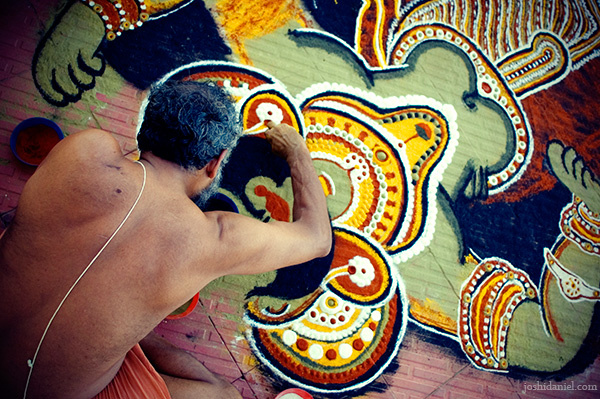The art of Kalamezhuthu from Kerala
A temple art, the vivid drawings of the Kalamezhuthu are a representation of the beliefs of the people from the south Indian state of Kerala, where it is crafted and celebrated.
The air is light, crisp and fragrant. There are incense sticks placed next to the idols and the thin smoke that is curling up from them is adding to the meditative ambience. The whites of the jasmine flowers, the orange of the priest’s attire, the red from the embellishments on the walls, are making for a colourful treat inside this South Indian temple. such as temples of Belur from karnataka. It’s all very simple and soothing to the soul. The only thing that is standing out boldly and adding drama in the quiets of this place is the Kalamezhuthu art done on the entrance floor.
Intricately crafted and reciting temple stories through big and vivid drawings of gods and goddesses, it is the ritual art of Kalamezhuthu that decorates the floors of most temples in South India, particularly the temples of goddess Bhagavathy or Bhadrakali.
Similar to the floor arts of rangoli or kolam from other parts of the country, Kalamezhuthu too is made using powdered colours.
A temple art, the patterns of Kalamezhuthu are either depictions of the deities expressing powerful emotions or are inspired by various festivities.
All of the representations and emotions depicted are a reflection of the rituals and rarely an artist’s choice. The patterns, the order in which the art is to be constructed, every step is laid down beforehand and follows the religious rites. The colours are pre-decided as well. White, green, yellow and charcoal, the colours are all naturally made from rice, leaves, turmeric and paddy husk and are the only substance used to make the illustrations of the gods.
Depicting deities like goddess Kali or god Ayyappa from the religious sagas that are heard of in this part of the country, Kalamezhuthu rather vividly adds to the mysticism of a temple. Kalam, which literally translates to a picture in Malayalam and ezhuthu, which means the act of drawing, speaks for the believes of the people from Kerala.
Building art around faith
The ritual of Kalamezhuthu develops through three stages that revolve around the religious, aesthetic and social aspects. Firstly, the drawing or the Kalamezhuthu is made followed by Kalam Pattu, which involves the rendering of the myth related to the deity; and finally the Kalam Thullal, the stage in which the kalam is erased while the artists perform to the traditional drum beats. The drawing starts at appointed time and is erased immediately after the rituals related to the Kalam are over.
Kalamezhuthu artists are generally members of communities like the Kurups, Theyyampadi Nambiars, Theeyadi Nambiars and Theeyadi Unnis; and the kalams drawn by these people differ in only certain characteristics; nevertheless the rituals that revolve around the practice of this art are all the same.
Kalamezhuthu is conducted as part of the general festivities in the temple, or as part of other rituals like Nagapuja (prayer of the serpentine god). The ceremonies are performed by the artists themselves, usually traditional drummers. Rice and other grains that are offered are heaped close to the Kalamezhuthu.
As part of the celebrations, the scared space is decorated with flowers, leaves and garlands that add to the subtlety of the ambience, which is dimly lit by the oil lamps. Singing of hymns is another rite and it fills the temple air. The type of song varies considerably, from folk to classical depending on the deity being worshipped. Ritual songs that are sung in worship of the deity on completion of the kalam, are to the tunes of instruments like ilathalam, veekkan chenda, kuzhal, kombu and chenda and are part of an oral tradition performed by the artists themselves.










